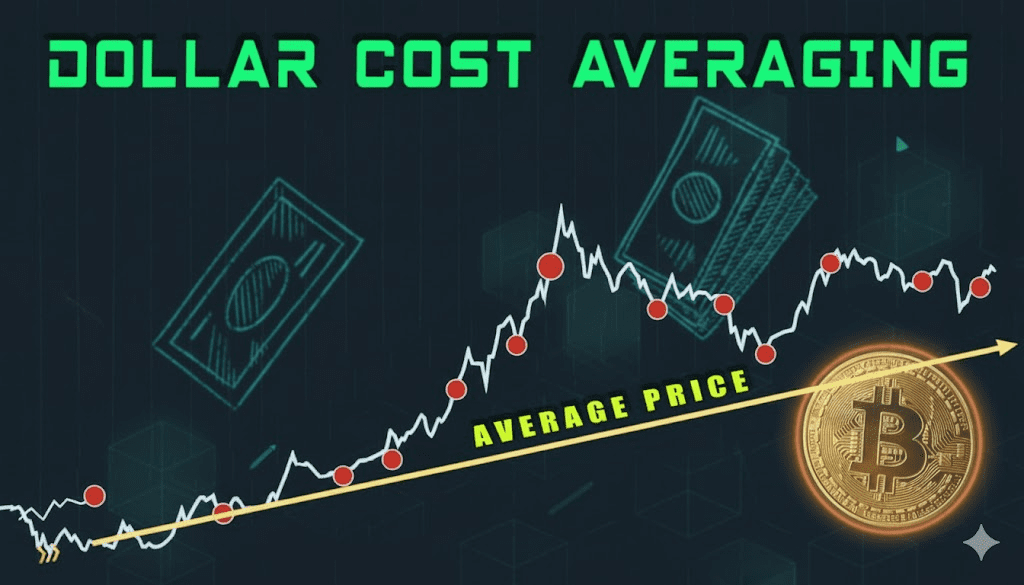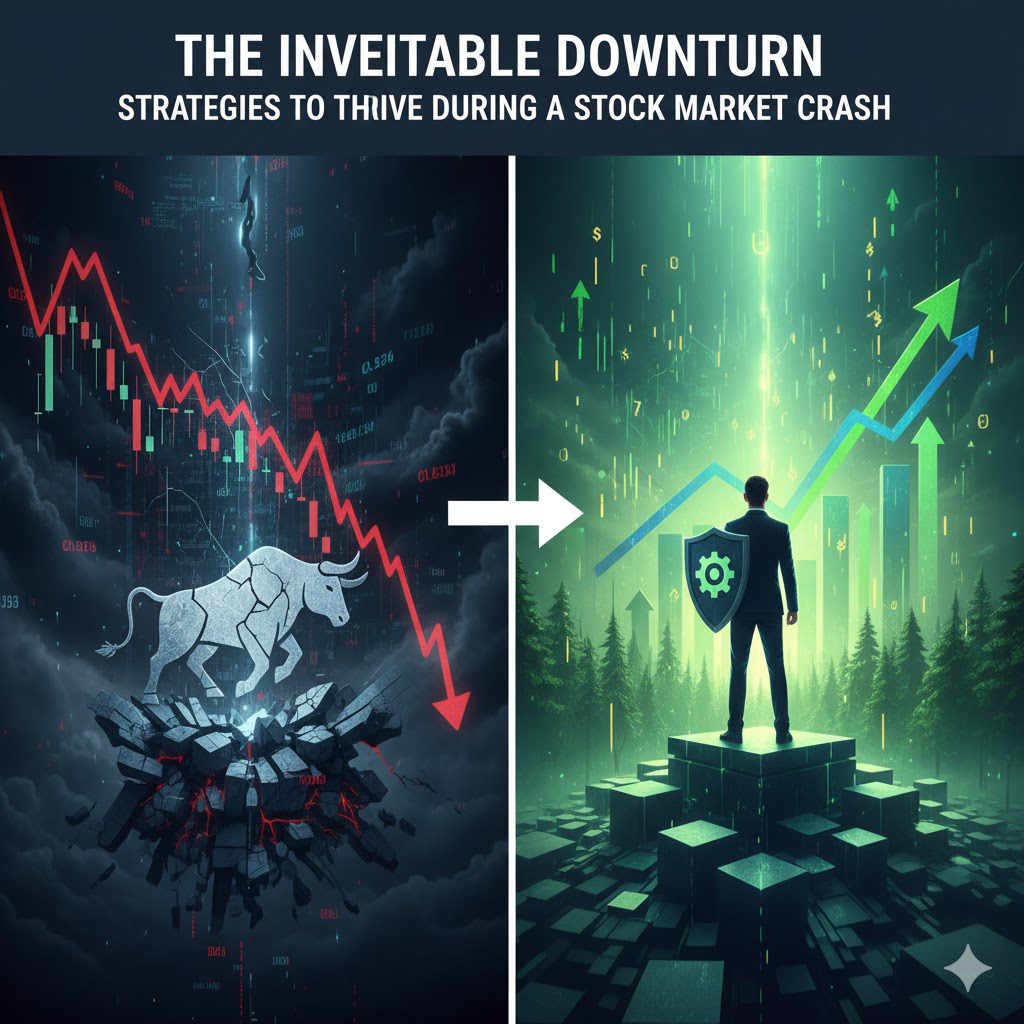Market crashes are a scary but inevitable part of investing. For prepared investors, however, these periods of chaos can be transformed into massive opportunities for wealth creation. This article outlines the three phases of a market decline, the clear warning signs of a looming crash, and the actionable strategies seasoned investors use to emerge wealthier on the other side of economic turmoil.
The Scary Truth: Market Declines Are Common and Predictable
The stock market will crash. It is a fact proven time and time again by economic history. While the prospect of a severe market decline is unsettling, it does not have to be a negative event for your personal finances. For investors who are properly prepared, periods of volatility and chaos are historically the most profitable times to acquire high-quality assets at bargain prices. By understanding the cyclical nature of the market and applying disciplined strategies, any investor can learn to spot the warning signs of a crash and use the chaos to their distinct advantage.

To invest successfully, one must first recognize that market declines come in different forms and frequencies. There are three primary classifications of market drops:
- The Market Correction: This is the most common type of decline, defined as at least a 10% drop from a recent high. Corrections are often caused by the market simply realizing that prices have become a bit too expensive relative to fundamentals, prompting a necessary pullback. Historically, market corrections have occurred on average every 1.2 years since 1980. They are a normal, healthy part of the economic cycle.
- The Bear Market: A bear market is officially declared when prices have dropped more than 20% from a recent high. Since 1932, these bear markets have popped up on average every four years and eight months. They tend to keep dragging the market down for a significant period, often lasting around 289 days, or roughly 9.6 months. However, it is essential to keep perspective: the preceding bull markets (when the market is going up) usually last significantly longer, typically around 965 days or 2.6 years.
- The Stock Market Collapse (or Crash): This is the most severe and uncommon type of decline, characterized by an over 30% drop in the stock market, normally occurring within a very short amount of time. While rare, these events—like the 2008 Financial Crisis or the Black Monday crash of 1987—represent catastrophic failures of systemic confidence. For context, historical analysis of sudden, unforeseen geopolitical events suggests that major instability can severely impact investor psychology, potentially triggering such a collapse due to the fragility of global finance during times of crisis.
The main takeaway from this historical data is clear: if an investor is not ready for the stock market to go down sometimes, they should not be investing in stocks. Volatility is the price of admission for long-term growth.
Phase One: The Euphoria Stage and Strategic Preparation
A market crash typically moves through three distinct phases, and the first—the Euphoria Phase—is where the signs of trouble first appear. This is the stage where the market reaches its peak, driven by irrational excitement and blind optimism that pushes asset prices to unsustainable, bubble-like levels. During this period, everyone seems happy and is flying high. When a seasoned investor starts seeing this blind happiness and widespread, risk-ignorant participation, they prepare their investments for the inevitable crash back to reality.
Spotting the Warning Signs
Experience shows that major financial crises are often preceded by noticeable sociological and economic clues. Before the 2008 financial crisis, for example, two primary indicators raised serious caution flags for alert investors:
- Excessive Consumer Spending and Debt Accumulation: The economy was thriving on debt-fueled spending, creating a boom where “everyone had money.” A more recent example is the NFT craze, where digital image files were transacting for millions of dollars. Such irrational speculation, divorced from intrinsic value, is a clear sign of too much money in circulation chasing too few good investments, signaling a bubble forming.
- Lax Credit Standards: The housing boom preceding 2008 was characterized by an ease of obtaining credit, allowing a surge in the number of people buying houses or refinancing with dangerously complex or predatory loans. This practice was enabled by banks who were confident they could recoup their money by seizing and re-selling property in a booming housing market. When credit standards become too loose and borrowing becomes excessively easy, it introduces systemic risk into the financial system.
Noticing these clues requires discipline, as the general herd mentality in the Euphoria Phase is that “everything is great and nothing will ever go wrong.” Seasoned investors understand that preparing for the worst when everyone else is celebrating is the only way to safeguard wealth.
Actionable Preparation Strategies
When the internal warning signs begin to register, an investor should take concrete actions to prepare for the downturn:
- Evaluate and Minimize Risk: The focus should immediately shift from chasing high returns to preserving capital. Personally, the goal is not to chase crazy high returns, which are often unsustainable, but to aim for reasonable gains consistently so money compounds safely. This slow-and-steady approach, like the tortoise and the hare, is built for long-term endurance. If an investor is new, they must mentally prepare for the potential horror of seeing a portfolio halve in value without panic selling.
- Reduce Leverage: While leverage (borrowing money to invest) can accelerate wealth, it is extremely dangerous during a crash. If a stock crashes too far, the investing platform may issue a margin call, forcing the investor to pay off debts immediately. Failure to do so means the brokerage may sell the client’s stocks at the bottom of the market to recover the borrowed money. Eliminating or significantly reducing margin debt is a crucial defensive move to avoid forced liquidations.
- Supercharge Cash Reserves: Beyond a standard three-to-five month emergency fund, investors should start saving extra cash in a high-interest savings account. While this may feel counterintuitive when the market is booming, excessive public interest in investing—especially from inexperienced investors—often signals a bubble forming. These inexperienced investors are prone to panic selling at the first sign of a crash, driving prices down further and creating the spiral of doom. Saved cash becomes “dry powder” to exploit the coming opportunities.
- Maximize Diversification: Proper diversification is one of the best ways to withstand a market crash, ensuring you haven’t put all your eggs in one basket. Since no one knows which sector will be hit hardest, spreading money across different industries and asset classes mitigates risk. For example, instead of putting all capital into a single high-growth stock (like a major technology company) with hopes of it “going to the moon,” investing in a total US stock market fund spreads money across thousands of companies in multiple industries. This is a crucial strategy for reducing volatility.
- Utilize High-Yield Cash Accounts: Another great way to diversify while guaranteeing a return is through a high yield cash account. For example, a $5,000 initial saving with an additional $250 saved monthly over five years, earning 5.1% interest compounded daily, would accrue $3,493 in earnings without taking on any investment risk. These accounts offer safety and liquidity, making them ideal for holding dry powder.
Phase Two: The Reckoning Stage and The Psychological Test
The second phase, the Reckoning Phase, is where reality sets in. Overvaluation triggers widespread panic, and sell-offs begin in earnest. The stock market comes tumbling down, and it is next to impossible to be unaffected. This is the stage that truly tests an investor’s discipline and psychological fortitude.

Holding Your Nerve
Most people’s initial reaction to seeing their portfolio drop is to panic sell and cut their losses. This is the ultimate mistake. Everyone claims to be a long-term investor until the market crashes. If you believe in your investments—the companies or funds you purchased—then you must hold firm. To have this kind of conviction, you need to deeply understand the fundamentals of a company before investing.
The story of legendary investor Peter Lynch highlights this. Lynch once bought shares in Kaiser Industries when they dropped significantly, noting the company had zero debt, making bankruptcy unlikely. Despite the price continuing to drop well below his initial purchase, he held firm based on his fundamental analysis, and the stock eventually rebounded sharply. The point is: if you don’t understand the company, you will panic and sell when the stock keeps dropping, losing out on potential gains.
The Cost of Timing the Market
Studies consistently prove the danger of trying to “time the market.” A study by Fidelity found that if an investor put $10,000 in a simple S&P 500 index fund between January 1, 1980, and December 31, 2022, they would have over $1,082,309. However, if that investor missed just the five best trading days during that period, their total would have dropped significantly to only $671,051. Missing just 50 of the best trading days brings the total down to a meager $76,104. These best trading days often occur immediately following the worst trading days, proving that time in the market consistently beats trying to time the market.
Buying the Dip: Dollar Cost Averaging
While many choose to panic sell, the prepared investor chooses to buy the dip. Observing the economic chaos—like the proliferation of dollar stores or the fire-sale of distressed assets that occurred in 2008—is key to identifying opportunities. Cash is king in the Reckoning Phase, as it allows investors to snap up amazing investments. The strategic approach is not to try to time the exact bottom of the market, which is impossible, but to invest consistently every week or month. This strategy is called dollar cost averaging (DCA). DCA ensures you buy more shares when prices are low and fewer when prices are high, lowering your average cost per share over time. This disciplined, patient accumulation of assets during a crash is the secret to building fortune in the next phase.

I feel like I should also mention that some investors like to short stocks, which is basically betting that a stock will go down. It’s not something I personally do. However, people like Michael Burry, whose story was popularized in the film The Big Short, have been very successful with this strategy.
Phase Three: The Phoenix Stage and Long-Term Wealth
In the final phase, the Phoenix Phase, the market begins its slow, powerful recovery, rising from the ashes of the crash. Historically, this recovery almost always pushes above and beyond the last market highs. For example, four years after the 2008 crisis, the economic environment began to noticeably improve, but it took several more years for consumer confidence and spending to return to normal levels.
The Seeds of Fortune
A key lesson taken from every major crisis—including Black Monday, the dot-com bubble, the 2008 Financial Crisis, and the 2020 pandemic—is that a bull market almost always follows a bear market. The seeds of long-term fortune are sown in times of crisis and uncertainty, when asset prices are cheap and most investors are running away.
The ultimate winning strategy is simple, yet profoundly difficult to execute: handle your level of risk, invest consistently with a diversified portfolio, and buy steadily throughout the downturn. Investors who successfully navigate all three phases—preparing defensively during Euphoria, holding firm during the Reckoning, and continuing to buy—position themselves for massive compounding gains during the Phoenix recovery.
Conclusion: Discipline is the Ultimate Edge
Market crashes are an unavoidable reality of investing, but they are not a reason for fear; they are an opportunity for wealth transfer. The knowledge that has helped seasoned investors succeed through multiple crashes is not about predicting the downturn, but about disciplined preparation and psychological fortitude. By recognizing the warning signs of the Euphoria Phase, reducing high-risk exposure like margin debt, building large cash reserves, and diversifying investments, an investor can weather the storm.
When the Reckoning Phase hits, the challenge is behavioral: holding your conviction, ignoring the panic of the crowd, and executing a consistent dollar-cost averaging strategy to buy assets at a discount. The consistent evidence of history is that the market always recovers and reaches new highs. Success is achieved not by being the smartest investor who can time the market, but by being the most disciplined investor who can stay the course, buying when others are selling, and allowing the natural power of the Phoenix Phase to deliver significant wealth.






